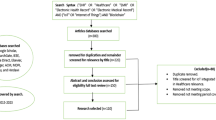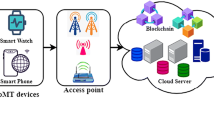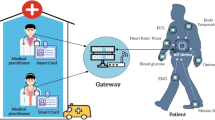Abstract
The security for Telecare Medicine Information Systems (TMIS) has been crucial for reliable dispensing of the medical services to patients at distant locations. Security and privacy element needs to be there for any physician or caregiver to make certain an appropriate diagnosis, medical treatment or any other exchange of critical information. In this connection, many relevant TMIS-based authentication schemes have been presented, however various forms of attacks and inefficiencies render these schemes inapplicable for a practical scenario. Lately, Amin et al. proposed a scheme based on a multi-server authentication for TMIS. However, the Amin et al., scheme has been found vulnerable to user and server impersonation attacks. We have proposed an improved model with higher performance and efficiency, as evident from the forthcoming sections. Besides, the scheme has been backed up by formal security analysis using BAN logic to ensure the resilience of the proposed scheme.






Similar content being viewed by others
References
Amin R, Islam SH, Biswas GP, Khan MK, Kumar N (2015) An efficient and practical smart card based anonymity preserving user authentication scheme for TMIS using elliptic curve cryptography. J Med Syst 39(11):1–18
Cao T, Zhai J (2013) Improved dynamic id-based authentication scheme for telecare medical information systems. J Med Syst 37(2):1–7
Certicom Research Standard for efficient cryptography, SEC 1 (2000) EC cryptography. ver. 1.0
Chang C-C, Cheng T-F, Hsueh W-Y (2014) A robust and efficient dynamic identity-based multi-server authentication scheme using smart cards. Inter J Comm Sys
Chaudhry SA, Farash MS, Naqvi H, Kumari S, Khan MK (2015) An enhanced privacy preserving remote user authentication scheme with provable security. Sec Commun Networks. doi:10.1002/sec.1299
Chaudhry SA, Mahmood K, Naqvi H, Khan MK (2015) An improved and secure biometric authentication scheme for telecare medicine information systems based on elliptic curve cryptography. J Med Syst 39(11):1–12
Chaudhry SA, Naqvi H, Shon T, Sher M, Farash MS (2015) Cryptanalysis and improvement of an improved two factor authentication protocol for telecare medical information systems. J Med Syst 39(6):1–11
Chen C-T, Lee C-C (2015) A two-factor authentication scheme with anonymity for multi-server environments. Sec Comm Networks 8(8):1608–1625
Chen HM, Lo JW, Yeh CK (2012) An efficient and secure dynamic id-based authentication scheme for telecare medical information systems. J Med Syst 36(6):3907–3915
Dodis Y, Kanukurthi B, Katz J, Reyzin L, Smith A (2012) Robust fuzzy extractors and authenticated key agreement from close secrets. IEEE Trans Inf Theory 58(9):6207–6222. doi:10.1109/TIT.2012.2200290
Dodis Y, Reyzin L (2004) Smith A (2004) Fuzzy extractors: how to generate strong keys from biometrics and other noisy data. Adv Cryptol—EUROCRYPT 2004 3027:523–540. doi:10.1007/978-3-540-24676-3_31
Farash MS, Chaudhry SA, Heydari M, Sajad Sadough SM, Kumari S, Khan MK (2015) A lightweight anonymous authentication scheme for consumer roaming in ubiquitous networks with provable security. Int J Commun Syst. doi:10.1002/dac.3019
Giri D, Maitra T, Amin R, Srivastava P (2014) An efficient and robust RSA-based remote user authentication for telecare medical information systems. J Med Syst 39(1):145. doi:10.1007/s10916-014-0145-7
He D, Jianhua C, Rui Z (2012) A more secure authentication scheme for telecare medicine information systems. J Med Syst 36(3):1989–1995
He D, Kumar N, Chen J, Lee CC, Chilamkurti N, Yeo SS (2015) Robust anonymous authentication protocol for health-care applications using wireless medical sensor networks. Multimedia Systems 21(1):49–60. doi:10.1007/s00530-013-0346-9
He D, Kumar N, Chilamkurti N (2015) A secure temporal credential-based mutual authentication and key agreement scheme with pseudo identity for wireless sensor networks. Inf Sci 321:263–277. doi:10.1016/j.ins.2015.02.010
He D, Wang D (2015) Robust biometrics-based authentication scheme for multiserver environment. IEEE Syst J 9(3):816–823. doi:10.1109/JSYST.2014.2301517
Hsu CL, Chuang YH, Kuo Cl (2015) A novel remote user authentication scheme from bilinear pairings via internet. Wirel Pers Commun: 1–12
Irshad A, Sher M, Chaudhary SA, Naqvi H, Farash MS (2016) An efficient and anonymous multi-server authenticated key agreement based on chaotic map without engaging Registration Centre. J Supercomput 72(4):1623–1644
Irshad A, Sher M, Faisal MS, Ghani A, Ul Hassan M, Ashraf Ch S (2014) A secure authentication scheme for session initiation protocol by using ECC on the basis of the Tang and Liu scheme. Sec Comm Networks 7(8):1210–1218
Irshad A, Sher M, Rehman E, Ch SA, Hassan MU, Ghani A (2015) A single round-trip SIP authentication scheme for voice over internet protocol using smart card. Multimed Tools Appl 74(11):3967–3984
Jiang Q, Ma J, Lu X, Tian Y (2014) Robust chaotic map-based authentication and key agreement scheme with strong anonymity for telecare medicine information systems. J Med Syst 38(2):1–8
Kalra S, Sood S (2013) Advanced remote user authentication protocol for multi-server architecture based on ECC. J Inform Sec Appl 18(2):98–107
Kilinc HH, Yanik T (2014) A survey of SIP authentication and key agreement schemes. Commun Surv Tutor, IEEE 16(2):1005–1023
Kim H, Jeon W, Lee K, Lee Y, Won D (2012) Cryptanalysis and improvement of a biometrics-based multi-server authentication with key agreement scheme. Comput Sci Its Appl–ICCSA 2012, 391–406: Springer
Koblitz N (1987) Elliptic curve cryptosystems. Math Comput 48:203–209
Kocher P, Jaffe J, Jun B (1999) Differential power analysis. Adv Cryptol CRYPTO 99, Lect Notes Comput Sci 1666:388–397
Lee TF, Chang IP, Lin TH, Wang CC (2013) A secure and efficient password-based user authentication scheme using smart cards for the integrated epr information system. J Med Syst 37(3):1–7
Lee CC, Hsu CW, Lai YM, Vasilakos A (2013) An enhanced mobile-healthcare emergency system based on extended chaotic maps. J Med Syst 37(5):1–12
Li CT, Lee CC, Weng CY (2014) A secure chaotic maps and smart cards based password authentication and key agreement scheme with user anonymity for telecare medicine information systems. J Med Syst 38(9):1–11
Li X, Ma J, Wang W, Xiong Y, Zhang J (2013) A novel smart card and dynamic id based remote user authentication scheme for multi-server environments. Math Comput Model 58(1):85–95
Li X, Niu J, Khan MK, Liao J (2013) An enhanced smart card based remote user password authentication scheme. J Netw Comput Appl 36(5):1365–1371
Li X, Niu JW, Ma J, Wang WD, Liu CL (2011) Cryptanalysis and improvement of a biometrics-based remote user authentication scheme using smart cards. J Netw Comput Appl 34(1):73–79
Li X, Xiong Y, Ma J, Wang W (2012) An efficient and security dynamic identity based authentication protocol for multi-server architecture using smart cards. J Netw Comput Appl 35(2):763–769
Liao X, Shu C (2015) Reversible data hiding in encrypted images based on absolute mean difference of multiple neighboring pixels. J Vis Commun Image Represent 28(4):21–27
Lin HY (2013) On the security of a dynamic id-based authentication scheme for telecare medical information systems. J Med Syst 37(2):9929. doi:10.1007/s10916-013-9929-4
Lin HY (2014) Chaotic map based mobile dynamic id authenticated key agreement scheme. Wirel Pers Commun 78(2):1487–1494
Lin I, Hwang M, Li L (2003) A new remote user authentication scheme for multi-server architecture. Futur Gener Comput Syst 19(1):13–22
Messerges TS, Dabbish EA, Sloan RH (2002) Examining smart-card security under the threat of power analysis attacks. IEEE Trans Comput 51(5):541–552
Miller V (1986) Uses of elliptic curves in cryptography. Adv Cryptol CRYPTO’85 Lecture Notes Comput Sci 218:417–426, Springer-Verlag
Mishra D (2015) Design of a password-based authenticated key exchange protocol for SIP. Multimed Tools Appl: 1–22
Mishra D, Mukhopadhyay S, Chaturvedi A, Kumari S, Khan MK (2014) Cryptanalysis and improvement of Yan et al’.s biometric-based authentication scheme for telecare medicine information systems. J Med Syst 38(6):1–12
Mishra D, Srinivas J, Mukhopadhyay S (2014) A secure and efficient chaotic map-based authenticated key agreement scheme for telecare medicine information systems. J Med Syst 38(10):1–10
Odelu V, Das AK, Goswami A (2014) Cryptanalysis on robust biometrics-based authentication scheme for multiserver environment. Tech. rep., Cryptology ePrint Archive, eprint. iacr.org/2014/715.pdf
Odelu V, Das AK, Goswami A (2015) A secure biometrics-based multi-server authentication protocol using smart cards. Inform Forensics Sec, IEEE Trans 10(9):1953–1966
Ren Y, Shen J, Wang J, Han J, Lee S (2015) Mutual verifiable provable data auditing in public cloud storage. J Internet Technol 16(2):317–323
Shen H, Gao C, He D, Wu L (2015) New biometrics-based authentication scheme for multi-server environment in critical systems. J Ambient Intell Humaniz Comput 6(6):825–834
Tan Z (2013) An efficient biometrics-based authentication scheme for telecare medicine information systems. Network 2(3):200–204
Wang Z, Huo Z, Shi W (2015) A dynamic identity based authentication scheme using chaotic maps for telecare medicine information systems. J Med Syst 39(1):1–8
Wang D, Ping W (2014) Understanding security failures of two-factor authentication schemes for real-time applications in hierarchical wireless sensor networks. Ad Hoc Netw 20:1–15
Wei J, Hu X, Liu W (2012) An improved authentication scheme for telecare medicine information systems. J Med Syst 36(6):3597–3604
Wu ZY, Lee YC, Lai F, Lee HC, Chung Y (2012) A secure authentication scheme for telecare medicine information systems. J Med Syst 36(3):1529–1535
Xia Z, Wang X, Sun X, Wang Q (2015) A Secure and Dynamic Multi-keyword Ranked Search Scheme over Encrypted Cloud Data. IEEE Trans Parallel Distrib Syst 27(2):340–352
Xie Q, Liu W, Wang S, Han L, Hu B, Wu T (2014) Improvement of a uniqueness-and-anonymity-preserving user authentication scheme for connected health care. J Med Syst 38(9):1–10
Xie Q, Zhang J, Dong N (2013) Robust anonymous authentication scheme for telecare medical information systems. J Med Syst 37(2):1–8
Xu L, Wu F (2015) Cryptanalysis and improvement of a user authentication scheme preserving uniqueness and anonymity for connected health care. J Med Syst 39(2):1–9
Yan X, Li W, Li P, Wang J, Hao X, Gong P (2013) A secure biometrics-based authentication scheme for telecare medicine information systems. J Med Syst 37(5):9972. doi:10.1007/s10916-013-9972-1
Yoon EJ, Yoo KY (2013) Robust biometrics-based multiserver authentication with key agreement scheme for smart cards on elliptic curve cryptosystem. J Supercomput 63(1):235–255
Zhu Z (2012) An efficient authentication scheme for telecare medicine information systems. J Med Syst 36(6):3833–3838. doi:10.1007/s10916-012-9856-9
Author information
Authors and Affiliations
Corresponding author
Rights and permissions
About this article
Cite this article
Irshad, A., Sher, M., Nawaz, O. et al. A secure and provable multi-server authenticated key agreement for TMIS based on Amin et al. scheme. Multimed Tools Appl 76, 16463–16489 (2017). https://doi.org/10.1007/s11042-016-3921-1
Received:
Revised:
Accepted:
Published:
Issue Date:
DOI: https://doi.org/10.1007/s11042-016-3921-1




